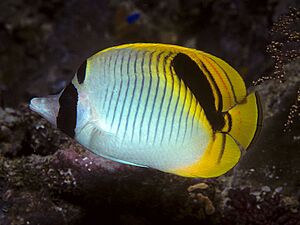Spot-nape butterflyfish facts for kids
Quick facts for kids Spot-nape butterflyfish |
|
|---|---|
 |
|
| Conservation status | |
| Scientific classification | |
| Genus: |
Chaetodon
|
| Species: |
oxycephalus
|
The Spot-naped Butterflyfish (Chaetodon oxycephalus) is a beautiful fish that lives in the ocean. It is also known as the pig-face butterflyfish. This fish is a type of butterflyfish, part of the Chaetodontidae family. You can find it in the warm waters of the Indo-West Pacific region. This area stretches from Sri Lanka to Queensland, and north to Indonesia and the Philippines.
Contents
What Does It Look Like?
This fish can grow up to 25 cm (9.8 in) long. Its body is mostly white. It has thin lines that go up and down its sides. There is also a large black area on its upper back.
Spot-naped vs. Lined Butterflyfish
The Spot-naped Butterflyfish looks very similar to the Lined Butterflyfish (C. lineolatus). But there are a few ways to tell them apart. The Spot-naped Butterflyfish has a black stripe over its eye. This stripe is broken above the eye. It also has more black and orange lines and spots. These colorful marks are found on its yellow top fin (called the dorsal fin) and its tail fin (called the caudal fin).
Where Does It Live and What Does It Eat?
The Spot-naped Butterflyfish likes to live in clear, warm waters. You can find it around coral reefs. It usually swims at depths of 10 to 40 meters. This fish loves areas with lots of coral. Its main food source is coral polyps. It also eats sea anemones.
Its Fish Family
The Spot-naped Butterflyfish belongs to a big group of fish called Rabdophorus. Scientists are still studying this group. They think it might even be a separate genus (a larger group of species).
Relatives in the Ocean
Within the Rabdophorus group, the Spot-naped Butterflyfish has some interesting relatives. These include the Lined Butterflyfish, the Black-wedged Butterflyfish (C. falcula), and the Pacific Double-saddle Butterflyfish (C. ulietensis). Even though these fish look different in shape, they share some common features. They all have bluish lines on a white body. They also have yellow areas towards their back. Plus, they have black markings on their back and near their tail. The Blue-cheeked Butterflyfish (C. semilarvatus) is another relative. It also has those special blue vertical lines.


